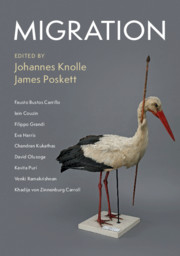Book contents
- Migration
- The Darwin College Lectures
- Migration
- Copyright page
- Contents
- Figures
- Notes on Contributors
- Acknowledgements
- Introduction
- 1 Black and British Migration
- 2 Immigration and Freedom
- 3 Art and Migration
- 4 Refugees and Migration
- 5 Migration of Disease
- 6 The Partition of India and Migration
- 7 Migration in Science
- 8 Animal Migration
- Index
- References
5 - Migration of Disease
Dengue and Zika across Continents, around Cities, and within the Human Host
Published online by Cambridge University Press: 25 March 2020
- Migration
- The Darwin College Lectures
- Migration
- Copyright page
- Contents
- Figures
- Notes on Contributors
- Acknowledgements
- Introduction
- 1 Black and British Migration
- 2 Immigration and Freedom
- 3 Art and Migration
- 4 Refugees and Migration
- 5 Migration of Disease
- 6 The Partition of India and Migration
- 7 Migration in Science
- 8 Animal Migration
- Index
- References
Summary
Dengue virus, the cause of tens of millions of cases of dengue annually, and Zika virus, the cause of recent explosive epidemics across Latin America associated with congenital defects and microcephaly, are pathogens with a significant burden on human health and well-being. Beyond their toll on health, these flaviviruses, as the genus is called, share a common evolutionary origin, have each adapted to replicate efficiently in the human host, and are spread by similar species of mosquitoes. These commonalities belie important clinical, epidemiological, and immunological differences between them that necessitate continued research into their respective biology. Moreover, these commonalities and differences have real consequences for control efforts in affected areas around the world.
- Type
- Chapter
- Information
- Migration , pp. 96 - 130Publisher: Cambridge University PressPrint publication year: 2020



